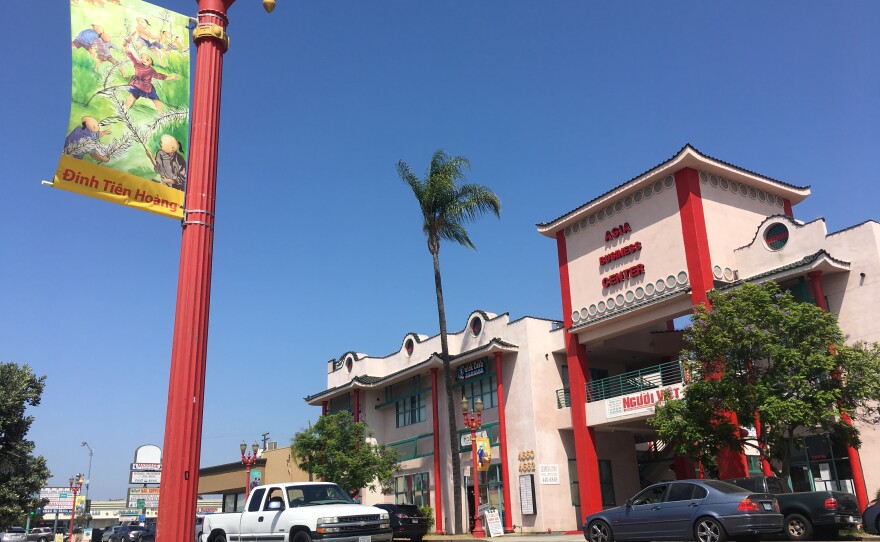You might not immediately notice AA Fashion in a small strip mall off bustling El Cajon Boulevard in San Diego’s mid-city area. The shop sells vibrant garments made in Vietnam and it's tucked in the corner among a cluster of Asian businesses, including eateries, a hair salon and a market. But owner Ann Chan said lately she’s seen more tourists wandering into her shop.
“I say, 'You look like stranger,' and they say, 'I come from different state,'” Chan said.
The "strangers" tell her they’ve come to explore the city’s Little Saigon Cultural and Commercial District, which is where her operation sits. The city formally recognized the six-block concentration of Vietnamese-run businesses in 2013. Now neighborhood groups want statewide recognition for the district and to include the community's other cultural hubs.
A collection of community organizations known as the City Heights Economic Development Collaborative, or CHEDC, is seeking a California Cultural District designation to boost commercial activity in the lower-income area while preserving the immigrant neighborhood's multicultural identity. The effort is similar to other initiatives in San Diego and across the U.S. to push back against gentrification.
Beryl Forman of the El Cajon Boulevard Business Improvement Association, a CHEDC partner, said the designation is an opportunity to officially acknowledge the area's unique blend of Asian, African and Latino cultures.
“City Heights has always been touted as an area that has an immense amount of diversity in the way of 40-plus languages spoken, so that’s something to be celebrated...” Forman said.
But it's also about ensuring that identity isn't forced out. The designation could help the community build a brand to boost revenue for existing businesses.
“Then, working toward economic strategies that enable people to stay here...” Forman said.
Displacement was also a concern for the Barrio Logan neighborhood, which is rich in Chicano art and history. Miguel Alatorre of the nonprofit Logan Avenue Consortium said the community had experienced a boom from the group’s events along the main corridor, but there was worry it could have adverse effects.
“Our biggest concern was that because we were being so successful on Logan Avenue, for example, that the businesses that were thriving would be forced out," Alatorre said. "That the artists that were becoming well known or really active in the community would be forced out too because their rents were too high or they couldn’t afford it."
Maintenance Assessment District Manager Marissa Cassani worked with Alatorre and other groups to submit the application. Barrio Logan earned the cultural designation last year.
"Barrio Logan is a renting community, we don’t want the rents to go up and displace families," Cassani said. "So maybe through this cultural designation and promoting preservation, preservation — preservation of everything; Culture means residents, arts, business, new business coming in. And so we just want to have some sort of control."
She said the designation doesn't directly offer protections against neighborhood changes, such as building alterations or new developments, but it does promote collaboration among entities that include the planning committee, business owners, cultural organizations and art galleries.
Columbia University doctoral student Jenna Dublin said there are other communities across the country, including in New York and North Carolina, leveraging historic and cultural preservation tools to accomplish a similar goal.
"I’m seeing that groups are interested in looking at the ways that that district designation can have a role in slowing down some of the physical changes in their neighborhood," Dublin said in a Skype interview.
Dublin, who holds master's degrees in community planning and historic preservation, said the recognition can bolster community organizing to help groups lobby against changes they may disagree with.
“Maybe the process of coming together to get a designation kind of brings people who haven’t really interacted with development plans, private developers to the table for the first time and you know that’s another way to just have more like a feeling of political and local power," said Dublin, who is also a consultant for the National Trust for Historic Preservation.
Alatorre in Barrio Logan said that collaboration is one of the early benefits he saw from the cultural designation.
“It’s good that we’re all on the same page whereas before a lot of us didn’t talk to each other back then. it’s really just been a blessing to the community I think," he said.
He admits the certification hasn’t solved all the issues facing the community. Rising rents are still a concern, but he said the cultural district designation gives the community a platform to negotiate with property owners.
In City Heights, Forman said conversations around the district application and proposed boundaries, which are due sometime next year, have already brought organizations together to benefit the community. At a past meeting, the founder of a nonprofit coffee shop mentioned he was facing a deadline to fund a solar project for nearby high school kids. The City Heights Business Association offered the money on the spot.






